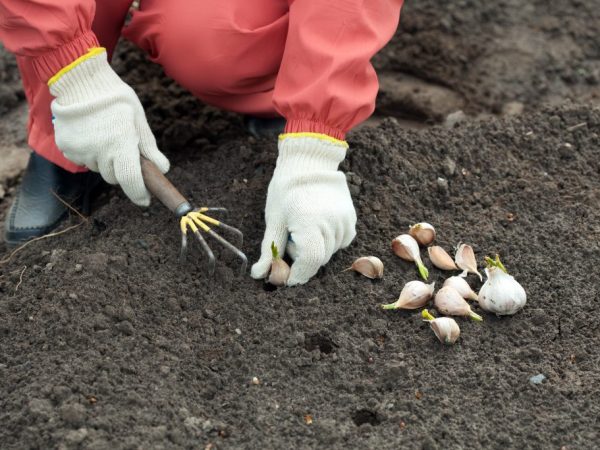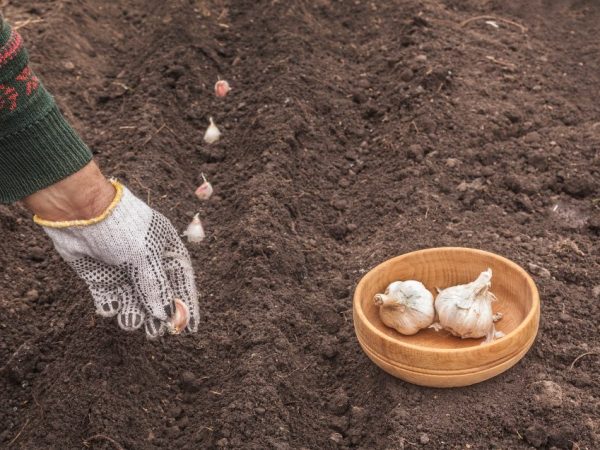How to transplant garlic in spring
In order not to get a harvest of mixed type of garlic, it is necessary to transplant it to a new place. Consider how to transplant garlic in the spring without harming your crop.

We transplant garlic in spring
Transplant rules and procedure
A winter garlic transplant is done for many reasons. For example, a vegetable planted before winter did not survive the cold and not all rose up in the spring. As a result, a large number of rotten bulbs are often found in the beds. The transfer of seedlings is carried out on pre-prepared beds. The rules and principles of planting are almost identical to planting a plant in the spring method.
Observing the rules of transplantation and care, you can get a crop of excellent quality. The basic principles, as well as the procedure for transplanting garlic, are the same for all its varieties.
General recommendations
It is recommended to locate sites for transplanting garlic on hills. The place should be warmed up by the sun and be reliably protected from the winds.
The optimal time for transplanting an overwintered plant is late March or early April. By this time, bald spots in the garden are already clearly visible. The timing depends on the region and the band.
Garlic is transplanted in dry warm weather. It is better to do this in the middle of the day or in the late afternoon. The soil in the new location should not stick to hands and garden tools. But the soil, where the vegetable is already growing, should be watered well in a day.
When choosing a site for transplanting, you should make sure that the plant is fenced off from onions. The distance between them should be at least 3 m. The best neighbors for garlic will be legumes and cruciferous crops: beans, peas, cabbage and radishes.
Preparing the beds
It is possible to transplant winter garlic, which has already sprouted and has its own root system, only in soft soil. Therefore, the earth should be dug up. It is better to loosen the beds for transplanting a winter spicy vegetable with a pitchfork, not a shovel.
The selected plot of land must be fertilized. The best growth promoters are:
- wood ash;
- azophoska;
- potassium magnesium.
Chemical complex substances are introduced strictly adhering to the recommended dosage. Ash is used at the rate of 1 kg per 1 m². All mineral fertilizers are applied before digging. The preparation of the site is completed by leveling the soil with a rake.
Transfer
Failure to follow the recommendations for transplanting will lead to a decrease in the quality of the bulbs.
Transplant procedure:
- Holes are marked in a new place. The distance between the plants should be 15 cm, and the row spacing should be at least 30 cm. It is convenient to make a hole under the clove using a thick stick. The pit height should be no more than 10 cm.
- The risen garlic is dug out one at a time. For this purpose, a heart-shaped garden shovel with a short handle is used. The tool is placed at a distance of 5 cm from the germination site and slowly buried in the ground.
- With their free hand, they carefully grasp the green leaves and slowly pull the plant up, trying not to make sudden movements.Careless action can lead to the foliage being torn off. Then it will be inconvenient to get the clove out of the ground.
- The plant is transferred along with a lump of earth to a permanent place and buried in a prepared hole.
- After all the cloves are planted, the holes are sprinkled with earth.
- The area with garlic seedlings is watered and then covered with white agrofibre for about a day.
Correctly transplanted garlic will take root already on the fifth day. This is evidenced by the leveling of the tops and the acceleration of their growth.
Post-transplant care

We seat at a distance
Top dressing
Garlic, transplanted in the spring to a permanent place, requires more attention than spring or winter crops. The main efforts should be directed to the rooting of seedlings. For this, it is recommended that root feeding of plants is carried out once every 10 days. You need to apply fertilizer three times.
At the time of the formation of the ovary and during the period of active growth, the bulbs are poured with infusion of mullein or bird droppings. Top dressing is prepared from 1 kg of fresh manure, diluted in 10 liters. water. Fertilizer is infused for 3 days, and then again diluted with water. The working concentration of natural mullein fertilizer is 1 liter. infusion for 10 liters. water. Chicken droppings are more concentrated, so the final product is prepared from 500 ml of the substance and 10 liters. water.
Watering
The transplanted garlic requires watering and timely loosening of the row spacings. The latter prevents water from stagnating and prevents root rot.
Mulching
To optimize metabolic processes in the soil, the soil should be mulched. For these purposes, use:
- grass;
- needles;
- bark of coniferous trees;
- dry straw;
- rotted wood shavings.
They also cover the ground with medium density agrofibre. Do not use the bark of fruit trees, as well as fresh sawdust, for mulching the row spacing. These materials, when naturally decomposed, attract parasites and damage the soil.
Topping
The transplanted garlic needs to be removed. They are harvested after the length of future inflorescences reaches 10 cm. The best way is to pinch the shoots at the base. The sooner the testes are ripped out, the larger and healthier the bulb will be.
Pest control
In case of soil contamination with pests, a standard complex of control is carried out. Insecticides and fungicides are used that do not affect the quality of the crop, presentation and keeping quality of the vegetable.
Benefits of the procedure
The transplanted vegetable has a number of differences from winter or spring plants. The main indicators for comparison are the size of the bulbs and the timing of their ripening.
Transplanted winter garlic usually has more prongs than conventional planted garlic. This is due to the rooting process of the plant. The ripening of the transplanted vegetable is shifted by about two weeks ago. Dead foliage and noticeable woodiness of the main stem are signs that signal full maturity.
The harvest of winter garlic transplanted in spring is stored for a very long time.
Conclusion
With a spring transplant, the bulb will grow large. This procedure will significantly accelerate the development of culture and improve the quality of the fruit.


